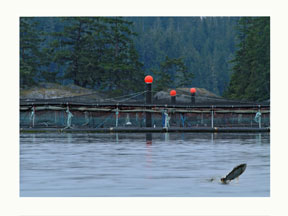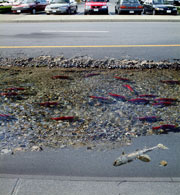by Christine Unger
 |
|
Barbara Zeigler
Escape
|
Every human is, by necessity, part of a freshwater ecosystem, yet we have largely failed to identify our fates with the other life forms that inhabit our waterways, to some extent because we do not have a direct evidential familiarity with how our waterways are used and misused, either by nature or by humanity. We consider water a commodity rather than a part of our culture—something integrated into the greater story of how we live, have lived, and will live. Barbara Zeigler’s art is one that builds both conscience and consciousness. Her practice has consistently explored the theme of the interlocking relationships between humanity and its waterways, the networks created through the movement of water and the biology that migrates with them, the ways in which water shapes our civilization, and makes us part of our local ecologies. In her print and video installation Hidden Sites, Zeigler highlights the migration of the Pacific Salmon, the development of aquaculture, and the routes of human transit and waste disposal to reveal subtle networks that equate the fragility of the salmon’s continued existence with our own.
As a printmaker of great technical breadth and capability Zeigler has not only embraced the role of the photographic process in printmaking but has helped develop it. In a 1975 review of a group show titled A Printmakers’ Print Show, critic Benjamin Forgey notes that in Zeigler’s work, “Imagined reality is often conjoined with meticulous observation of the real world.” Her interest in evoking a credible “reality” capable of provoking an awareness of our inter-connectedness and reliance on our environment makes Zeigler’s highly refined photographic processes and digital manipulations an integral part of her message. Her giclée prints are perfectly adapted to their content. She creates landscapes that, through their subtly interlocked layers, reveal a reality of more depth than the strictly factual half-truths of a photographic snapshot or the deniable beauty of any hand-rendered illustration. Her seamlessly interwoven images are created in such a way that the viewer is not distracted by technique but rather are engrossed in the complexities and paradoxes the imagery suggests.
 |
|
Barbara Zeigler
Parking Lot
|
Barbara Zeigler’s ‘reality’ pushes the audience to build an awareness of a series of connective truths. Her uncompromising imagery speaks of the life and death struggle connected to our consumptive use of resources. In our everyday lives our parking lots are comfortably distanced from the cool running water of a riverbed and so we fail to make a conscious connection between the burning and leaking of oil that comes with our roads and vehicles: the way it saturates the air and the water that runs off the pavement to pollute the waterways which the salmon rely on. We almost smell the reek of burning oil in Zeigler’s Parking Lot in which a lineup of parked cars hovers on the horizon like a predatory pack. Below, the salmon, living and dying in too-shallow water, apparently just at the edge of a sidewalk, are literally trapped between our “driving” needs and our overwhelming requirement for infrastructure. In Under Siege the orange flames that lick at the side of a log are seen to live, intermingled, among the red of the spawning salmon, linking our consumption of combustion fuels to the fragile existence of the salmon. The contradiction of the coexisting heat, flames and curling smoke with the fresh, clear waters of the river make an inescapable point about the incompatibility of our energy-expensive lifestyles with the natural processes of a sustainable ecology.
 |
|
Barbara Zeigler
Under Siege
|
The superposition of human geometry dominates the natural landscape of Zeigler’s images. She avoids the conventional, romanticized portrayal of landscape, denying the sublime and transcendent in nature. She does not allow the implication of nature as eternal and unchangeable to apply a cathartic bandage, mitigating our responsibility for the ravages of human depredation. Above, through, and within the natural networks of our waterways, we are faced with the pervasive and unnatural networks of human kind. Three prints, Escape, Netted Fish Pen, and Sunday Afternoon, depict the “hidden sites” of Broughton Archipelago’s Atlantic Salmon aquaculture, drawing our attention to the unsettling reality of fish farms running side by side with the natural migration of the Pacific Salmon, profligately polluting through interactions inevitable in these highly permeable worlds. Contrasted to the ancient and equitable paths of salmon migration, Sunday Afternoon, makes our own, complacently trapped existence—our utter reliance on, and acceptance of, the nets and networks we have made—poignantly clear. Zeigler’s prints refute our confidence in the almost unquestioned perception of “B.C. the Beautiful” as a place rich in renewable “natural” resources and bountiful space for our leisured lifestyle.
 |
|
Barbara Zeigler
Sunday Afternoon
|
The video component of Zeigler’s installation adds yet another layer of compelling evidence for the truth of her ontological viewpoint. Tracking the five-hour journey of a garbage truck from Metro Vancouver to the Cache Creek Landfill, it is a horrifying testament to the fact that we are no less reliant on the geographic underpinnings of our waterways than the salmon but, at the same time, incapable of curbing our over-packaged and plastic-wrapped lifestyles towards a state of equilibrium with the very resources we require to sustain ourselves.
In the sciences, the confluence of waterways with the inevitable deposition of human waste has always been, and continues to be, the focal point of anyone curious about the pre-history and history of humankind and should be the focal point of anyone concerned about the future. Barbara Zeigler’s work makes us aware that this concern is not only for scientists, but must be a concern for us all. Her work affects us on a personal level with its specificity and immediacy, and challenges us with its global implications. With her restrained and contemplative aesthetics she imposes a geometric resonance over her landscapes that captures and directs our attention. Barbara Zeigler’s Hidden Sites builds consciousness of humanity’s deep connection and reliance on our waterways, and involves us in the very specific concerns of our contemporary overuse and disregard of our most essential resource. |